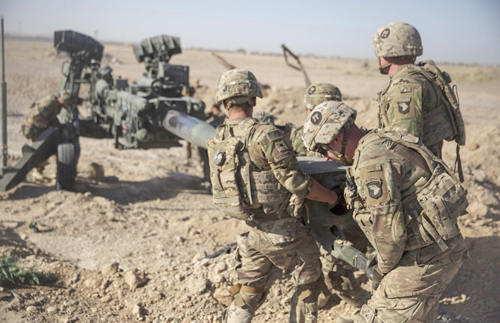
Vol. 81/No. 33 September 11, 2017
(front page)
White House sends more soldiers for US rulers’ war
in Afghanistan

The decision flows from the effort of the U.S. propertied rulers to defend their political and economic interests in the Middle East and South Asia as the post-World War II imperialist order continues to fray.
The move also reflects the weakened position of U.S. imperialism since the fall of the Stalinist regimes in the former Soviet Union and Eastern Europe in the 1990s. For decades Washington had relied on the Stalinist misleaders to block revolutionary struggles by working people around the world.
Trump’s decision to hold the line on U.S. military intervention in Afghanistan reverses his “original instinct,” which “was to pull out,” he said in his speech. In so doing he now owns the war.
The weak Afghan government, cobbled together by Washington and propped up by its firepower, would be easily overthrown by the Taliban if U.S. forces pulled out, Trump said. The reactionary Islamist organization, which ruled Afghanistan from 1996 to 2001 with many of its leaders coming from forces Washington backed to challenge Soviet rule there in the 1980s, has retaken control of almost 40 percent of the country.
The Trump administration’s Afghan war plans are consistent with previous administrations. The goal? Not to lose.
“It’s the same forever war,” Doug Ollivant, a fellow at the New America Foundation and former U.S. Army officer, told the Washington Post.
It involves a few thousand more troops, stepped-up bombings, more pressure on the Pakistani rulers to back off support for the Taliban and additional pressure on Kabul to tackle endemic corruption.
A side benefit, Trump said, will be “obliterating ISIS [Islamic State]” and “crushing al-Qaeda” forces there.
“We see this as a long-term campaign,” an unidentified U.S. military official in Kabul told the Post. By investing in the war, he said, the administration “and its NATO allies will be able to chart a way forward well into the 2020s,” the paper reported.
“This entire effort is intended to put pressure on the Taliban to have them understand: you will not win a battlefield victory,” Secretary of State Rex Tillerson told a State Department briefing the day after Trump’s speech. “We may not win one, but neither will you. At some point, we have to come to the negotiating table and find the way to bring this to an end.”
President Trump tried to differentiate his war policy from that of the Barack Obama administration. “I share the American people’s frustration. I also share their frustration over a foreign policy that has spent too much time, energy, money — and, most importantly lives — trying to rebuild countries in our own image instead of pursuing our security interests above all other considerations,” he said.
But despite the rhetoric, the Trump administration’s plan amounts to no more than tweaking the policy of the Obama administration.
Washington’s murderous war
Six days before Trump’s announcement the Taliban issued an open letter to Washington declaring that the military situation facing the imperialist forces in Afghanistan is “far worse than you realize.”
“Previous experiences have shown that sending more troops to Afghanistan will not result in anything other than further destruction of American military and economic might,” the Taliban said.
Afghanistan’s 33 million people, 90 percent who are Sunni Muslim, are among the poorest in the world. Few steps have been taken to advance modern infrastructure and capitalist development. Illiteracy is 60 percent and life expectancy is 51 years. Three-quarters of the population live in the countryside. Less than 50 percent have access to electricity.
Despite being landlocked, Afghanistan’s location is strategic. Washington and its capitalist competitors in the region are looking to control the development of oil and gas pipelines linking Central with South Asia. To advance their interests in the region, both Tehran and Moscow are deepening ties with different factions of the Taliban.
Since the war started in 2001 more than 110,000 Afghan civilians and soldiers have been killed along with over 2,400 U.S. soldiers and 1,000 from the 38 other NATO countries that have troops there. Civilian war deaths have been rising steadily from about 2,750 in 2012 to 3,500 last year according to the United Nations.
Related articles:
Afghan refugees protest deportations in Sweden
Front page (for this issue) | Home | Text-version home